Since every automotive engine comes fitted with a fuel pressure regulator, the performance of the engine is limited to the factory settings. To fulfill the cravings of the automotive enthusiast, custom fuel regulators made their way to the market. They offered many advantages and the comfort of customization to the normal regulator circuit. Certain factors come into the picture while selecting such pressure regulators.
Regulator pressure: A fuel pressure regulator handles the amount of fuel pressure that is sent to the fuel intake manifold. The pressure is kept equal to the pressure of the fuel rail. When the regulator pressure is too high, the fuel delivery is more than air. This floods the engine cylinder with extra fuel. Similarly, if the regulator pressure is too low, the engine cylinder runs on a lean mixture, and problems in acceleration, engine misfiring, etc might arise. Fuel pump size: Fuel pumps run parallel with the fuel pressure regulators. The fuel is supplied from fuel pups to the pressure regulators. The flow rate of the fuel pump must match the pressure regulating the capacity of the fuel pressure regulator. If the fuel pump flow rate is high, the regulator won’t be able to bypass the extra amount of fuel which might lead to a clogged fuel rail. The Number of Return Ports: Since a fuel pressure regulator compensates for the change in fuel delivery needs, it is mandatory for it to return the excess amount of fuel back to the fuel tank. This ensures no clogging of the fuel rail or the engine cylinders with extra fuel. The number of return ports helps to revert this fuel. This enhances the regulator’s bypass capacity and helps increase the performance of the engine.
A good pressure regulation helps in enhancing performance as well as fuel efficiency. By discussing the above-mentioned factors, an ideal fuel pressure regulator can be bought. The customized pressure regulator market is full of better alternatives than your car’s stock regulator. To help you choose the right regulator, we have made a detailed list of such pressure regulators below. These options will surely enhance your engine’s performance and hence your driving experience. “Buying Guide”
Best Fuel Pressure Regulator 2023
Best Fuel Pressure Regulator Reviews
1. AEROMOTIVE Fuel Pressure Regulator
Best Transistor Tester Best Non Contact Voltage Tester Best Outdoor Low Voltage Transformers Best Voltage Converter Transformer Best Fuel Pressure Tester
We will start this list with our first product coming from Aeromotive Inc. Being a well-known manufacturer of high-performance automotive parts, Aeromotive Inc. offers a wider range of fuel delivery products. The experience of over three generations in aftermarket fuel delivery products can be seen on every product. Aeromotive 13129 Fuel Pressure Regulator is one of the regulators which works with electronic fuel injection systems. This pressure regulator works on the 1:1 setting which means the pressure regulator will convert fuel pressure equal to the intake manifold pressure. This helps in maintaining the correct air-fuel mixture even at higher engine speeds. The regulator pressure can be adjusted between 30 to 70 psi which adapts to the uneven driving speeds. The pressure regulator is provided with two inlet and outlet ports as well as one return port. These ports are orb-06 (O ring boss) which allows standard fitting size. One gauge port of standard ⅛ inch size is also provided to fit the pressure gauge for the maintenance process. Best Features:
Pressure range adjustable from 30 to 70 psi The fuel pressure ratio of 1:1 when in a heavy loading condition Standard O-ring boss ports for inlet, outlet, and return line Standard ⅛ inch port to fit a pressure gauge
Pros:
Supports high-capacity engines of up to 1000 HP Durable body made up of performance-grade aluminum Easily handles high flow rates from a fuel pump
Cons:
The regulator is priced higher than the competitors
2. WATERWICH Fuel Pressure Regulator
Waterwich pressure regulators are known for their aftermarket automotive products. It offers a wider range of products in fuel delivery solutions. Their products follow the international size standards and are hence compatible with almost any fuel system. Watewich also offers all-in-one kits for their products which eliminates the headache of buying each component separately. The Waterwich Aluminium Fuel Pressure Regulator is a no-nonsense pressure regulator. It is designed to offer a variable pressure change as per the changing engine conditions. The pressure can be adjusted from 0 to 100 psi which is suitable for both performances as well as fuel-efficient settings. The inlet and the return ports are standard 6AN ports while the gauge port is a 1-¾ inch port. These allow standard fitting of the hose and pressure gauge. This fuel pressure regulator also comes with a pressure gauge which can be used to monitor the pressure reading. The standard size hose is provided for easy fitting with the ports. The hoes are made up of woven nylon with stainless steel and aluminum material for extra durability. The pressure settings are easily adjustable. Best Features:
Fuel pressure capacity adjustable between 0 to 100 psi Standard 6AN inlet and return ports Gauge port of 1-¾ inch size to fit a pressure gauge
Pros:
Better fuel efficiency No interference with electronic modules of the vehicle while setting pressure Steady flow delivery at high speed of the engine Value-for-money due to the extra kits available
Cons:
Not suitable for lower pressure settings
3. AEM Fuel Pressure Regulator
AEM Performance Electronics is one of the most innovative aftermarket product manufacturers. This innovation reflects in their wider range of products which results in customer satisfaction. The high-performance pressure regulator mentioned below is popular amongst racing enthusiasts. The AEM 25-300BK High Volume Fuel Pressure regulator is a performance grade regulator. The pressure regulator is designed in a way that allows a wider pressure range setting. The lowest pressure setting is 20 psi which can be increased to the maximum limit of the fuel pump capacity. You might be confused about how that is possible. Well thanks to the interchangeability of the discharge ports, the regulator bypass capacity increases dramatically. The regulator comes with a barb fitting which helps in connecting a standard hose to the regulator ports. The ports of the AEM fuel pressure regulator are tapped to a standard size of 9/16- inch 6AN ports. This allows a tight fitting of the connecting hoes and eliminates the leakage of fuel through loose gaps. It also helps in maintaining the pressure level of the regulator. Best Features:
Adjustable fuel pressure setting from 20 psi to the maximum limit of the connected fuel pump Discharge ports with interchangeability Standard 9/16-inch 6AN ports
Pros:
Adaptive bypass capacity helps to discharge extra fuel back to the fuel tank, increasing fuel efficiency Suitable for older automotive fuel systems too Supports engine capacity of up to 1000 HP
Cons:
The price of the regulators is high than the competitors
4. PTNHZ RACING Fuel Pressure Regulator
PTNHZ Racing has a good range of aftermarket fuel delivery products. These products are compatible with the stock fuel system of most vehicles. Simple construction and easy-to-use products make it an ideal choice for DIY modifiers. The next product follows the signature quality and durability of PTNHZ racing. PTNHZ Racing Manual Adjustable Fuel Pressure Regulator is a sturdy pressure regulator. The body of this pressure regulator is made up of aluminum and hence offers good strength to the body. The pressure regulator is suitable for carburetors and can be used with facet fuel pumps. The pressure range of 1 to 5 psi might look lower but it is more than enough for a carburetor fuel system. The maximum input pressure is limited to 7 psi which comes in handy in performance modes of engines. The inlet and outlet ports come with standard threads which can fit an 8mm hose perfectly. The pressure regulator is also provided with hose clips that clamp the hose to the ports and avoids any kind of fuel leakage. The kit also comes with a carburetor which is compatible with this pressure regulator. The adjustment of pressure is done by rotating the knob on the pressure regulator body. Best Features:
Stiff aluminum body with chrome plating Pressure range adjustable from 1 to 5 psi with 7 psi maximum limit Compatible with facet fuel pumps Threaded ports for standard fitting of hose
Pros:
Clamps provided for leakage-proof hose connection The pressure regulator can adapt to a twin carburetor configuration too
Cons:
Lower pressure handling capacity is not suitable for fuel injection engines
5. PQY Fuel Pressure Regulator
PQY Performance is another performance-oriented manufacturer on this list. This brand focuses on aftermarket products for fuel-injected systems. The amount of precision and durability of products grabs the attention of the consumers. The next product follows the same values of PQY performance. The PQY Fuel Pressure Regulator is a performance-tuned pressure regulator. The body of this pressure regulator is made up of a single aluminum billet which offers a good stiffness to the regulator body. The regulator offers adjustments of 60 to 85 psi pressure settings. This range can be extended by simply replacing the spring of the regulator. The regulator can be connected with a hose thanks to the standard ports. The inlet/feed port is a standard AN8 hole and the return port has a standard AN6 hole, both threaded. These threadings provide a tight fit with the hose thereby reducing the chances of leakage. The vacuum/boost port is also provided that allows a connection with the intake manifold. This helps the regulator to take feedback and adjust the pressure automatically to a 1:1 ratio. Best Features:
Single aluminum billet body with a pre-installed bracket Fuel pressure can be set from 60 To 85 psi with an upgradable spring option The feed port is a standard AN8 hole while the return port has a standard AN6 hole Standard ⅛ inch gauge port for pressure gauge
Pros:
The vacuum/boost connection port provides accurate pressure feedback Compatible with ethanol 85 and alcohol-based fuels Pressure settings are easy due to the adjustable screw
Cons
Leakage problem at lower pressure settings
6. RJSPHH Fuel Pressure Regulator
RJSPHH Fuel Pressure regulator is another addition to this list. This brand offers a wider range of fuel handling products for carburetor engines. Being a carburetor-oriented pressure regulator, the construction is compact. The detailed specifications are discussed below. RJSPHH Fuel Pressure Regulator is a durable pressure regulator. High-quality zinc alloy material is used for the body of the pressure regulator that offers good corrosion resistance to the body. The pressure regulator is designed for facet fuel pumps that use carburetors for fuel pressure control. The pressure can be set between 1 to 5 psi with an additional limit of 7 psi. This is enough for a carburetor fuel system. Adjustment of pressure is easily done by rotating the numbered dial on the pressure regulator body. The inlet/outlet ports come with standard threads which can fit an 8mm hose perfectly. The pressure regulator is also provided with steel clips for clamping the hose to the ports and eliminating any kind of fuel leakage. The pressure regulator can be used without the need for mounting thanks to the lightweight construction. Best Features:
Durable body made of zinc alloy material Pressure range adjustable from 1 to 5 psi with 7 psi maximum limit Compatible with facet fuel pumps Standard ports for easy connection with fuel hose of 8mm size
Pros:
Steel clips provided for leakage-proof connection with a fuel hose The pressure regulator body is corrosion resistant and can be used without the need for mounting
Cons:
Not compatible with fuel injection engines
7. YOKOLAS Fuel Pressure Regulator
Yokolas has been manufacturing high-performance products which cater to engine customization enthusiasts. Aftermarket pressure regulators of various specifications have flooded the market. What makes Yokolas stand out from the crowd is the affordable price tag for its quality products. Yokolos Fuel Pressure Regulator is a regulator compatible with fuel injection engines. The body is made up of aluminum alloy material. The regulator works well with electronically controlled fuel pumps. The pressure is adjustable and can go from 0 psi to 100 psi, making it a good choice for performance enthusiasts. The vacuum/boost line is provided for getting feedback from the intake manifold. This helps regulate the fuel pressure going to the engine cylinder. The pressure regulator is also provided with a pressure gauge which can be fit on the side of the regulator body. This helps in checking the working pressure of the regulator. The inlets and outlets are provided with standard AN6 fittings which easily fit the standard 6AN fuel lines. The adjustable screw helps in setting the pressure regulator settings easily. Best Features:
The body of the pressure regulator is made up of aluminum alloy Adjustable pressure range from 0 psi to 100 psi Standard AN6 inlet/outlet fittings 6AN nylon fuel lines with braided steel covering Pressure gauge for checking the regulator pressure reading
Pros:
Easy to set the pressure by using an adjustable screw Compatible with electric fuel pumps The lightweight construction of the regulator body
Cons:
The installation of the regulator might need a professional
8. JOHAHTANG Fuel Pressure Regulator
Last but not the least, Johahtang’s fuel pressure regulator made it to our list. Johahtang is also a performance-oriented manufacturer which specializes in aftermarket fuel delivery solutions. The use of Johahtang’s products enhances the fuel flow to the engine cylinder without the wastage of a single drop. Johahtang Fuel Pressure Regulator is a universal pressure regulator, which means it is compatible with any type of fuel-injected engine. The body of the regulator is made up of aluminum material which gives it a premium feel as well as stiffness. The pressure settings on the regulator start from 0 psi which goes up to the 140 psi mark. This is highest amongst all the competitors and suits the performance-hungry consumers. The regulator has a diaphragm that expands and contracts, giving the pressure valve the required settings for pressure control. Since the regulation of pressure is on the regulator level, no changes to the ECU or computer memory of the engine are needed. The regulator thereby prevents the stalling or flooding of the engine by maintaining pressure on the fuel. The regulator also comes with a pressure gauge for accurate readings. Two hoses are provided with the regulator for connecting the body with the intake manifold and fuel rail. Best Features:
The regulator body is made up of aluminum with a built-in diaphragm Pressure settings ranged between 0 to 140 psi Pressure reading gauge for accurate readings
Pros:
Offers high performance than the competitors Pressure regulation is achieved without interfering with the engine electronics Stalling or flooding of the engine is prevented
Cons:
Not suitable for very low-pressure settings
Buying Guide For The Best Fuel Pressure Regulator
The fuel pressure regulators turned out to be a good invention that helped engines revolve. Proper pressure provided by the pressure regulator results in a good air-fuel mixture. This enhances the performance of an engine and helps maintain good fuel efficiency. Various manufacturers have been introducing their own versions of fuel pressure regulators. A detailed list of these regulators was provided above. The selection process for the ideal pressure regulator is not hard. If you are still puzzled about the relationship between the regulator and its specification, we will make sure to clear your doubts through this buying guide. The guide will help you narrow down the best pressure regulator for you by covering all the important details.
1. Regulator Pressure
The important factor of any fuel pressure regulator is the pressure it can provide. The process involves taking feedback from the intake manifold where the air comes in from the turbocharger or air intake. When the intake manifold pressure is higher than the fuel regulator pressure, the regulator sends in more pressurized fuel thereby balancing out the pressure difference. A wider range allows for adaptive pressure regulation, eliminating stalling of the engine or flooding of the cylinders. The common pressure range for a normal fuel injection engine is between 40 psi to 60 psi. This range ensures the engines give a balanced performance with efficiency. In performance engines where efficiency does not matter, the regulator pressure goes above 60 psi. For the carburetor engines, the range is lower and limited to 3 to 10 psi.
2. Fuel Pump Size
The fuel pump works to transfer the fuel to the fuel rail system, toward the injectors or carburetors. The fuel pump size is focused on the flow rate it can offer. Bigger fuel pumps are able to provide a high flow rate. The pressure regulator then handles the flowrate and converts it into the required pressure level. If the flow rate of the pump is very high compared to the handling capacity of the regulator, it will lead to the clogging of the pressure regulator. This results in an uncontrolled flow of fuel to the intake manifold. To avoid flooding of the cylinders, fuel pump size needs to be chosen by keeping the pressure regulator capacity in mind.
3. Return Ports Capacity
The regulator consists of inlet ports, outlet ports, and return ports. The inlet and outlet ports are concerned with the fuel rail and intake manifold, where the pressurized fuel is needed. The return port is the port involved with the excess fuel flow. The pressurized fuel balances out the pressure requirement and the excess fuel gets diverted to this return line, which is connected to the fuel tank. If the return ports are not able to handle the excess flow of fuel, it might end up flooding the fuel rail. This results in a rich fuel mixture and loss of efficiency. The return ports are designed in a way to allow high fuel flow back to the fuel tank. Return ports can be increased in numbers to increase this backflow. If space is an issue, increasing the port diameter will also do the same job.
4. Engine Performance Level
Engine performance affects the regulator pressure indirectly. The high-performance engine needs a good fuel pump. A good fuel pump will need a performance-level pressure regulator. The engine fuel delivery parts are interdependent on each other. Hence engine performance will eventually lead to selection as an ideal fuel pressure regulator. Fuel pressure regulators are designed to withstand high engine performance levels. Most of the normal regulators can support 350-600 HP. The performance regulators are able to work efficiently up to 1000 HP too.
Conclusion
The pressure regulation of fuel has drastically improved engine performance and enhanced the automotive scene. The factory fit regulators were replaced by their aftermarket counterparts. The never-ending hunger of the motorheads has put these pressure regulators to their limits and made way for better alternatives. Such alternatives from different manufacturers were discussed earlier along with their detailed specifications. A buying guide was also included to help you clear any remaining confusion before purchasing the right fuel pressure regulator. Focusing on these factors, we have chosen our favorite pressure regulators:
Since the motorheads crave more and more performance, our first choice is the most powerful and high-pressure offering regulator. The JOHAHTANG Fuel Pressure Regulator was made for pure performance, It offers a 0 to 140 psi pressure setting which gives those extra pressure requirements at high engine speeds. The body is made up of aluminum adding to its stiffness. This regulator is a universal regulator and hence suitable for most fuel injection engines. The adjustment to the pressure levels is done on the go without interfering with the electronics, which is a plus point. It also comes with a pressure gauge to keep an eye on the readings. The next option was selected for being a feature-rich option in its price range. The WATERWICH Fuel Pressure Regulator Kit is an aluminum body regulator. It comes with an adjustable pressure range of 0 psi to 100 psi which is enough for fuel efficiency and performance needs. The inlet and return ports are standard 6AN ports which ensure easy fitting of the hose. The regulator comes with a kit that includes a pressure gauge that gives accurate reading thanks to its slow needle movement. The kit also includes stainless steel-covered woven nylon hoses which are durable. All these features come at a justified price tag. The last option is here to regulate the pressure on your pockets. The RJSPHH Fuel Pressure Regulator is an affordable option from the list. This regulator is a carburetor-compatible unit that is made up of zinc alloy material. This allows high corrosion resistance to the body and hence longer durability. The pressure can be set between 1 to 5 psi with room for a 7 psi setting (in case you need that extra boost). The adjustment of the pressure is easy to set via the rotating number dial. The inlet/outlet ports are compatible with an 8mm hose and provided with steel clips to offer a leak-proof bond. All these features at an affordable price tag go soft on your pockets.
Comment * Name * Email * Website
Δ



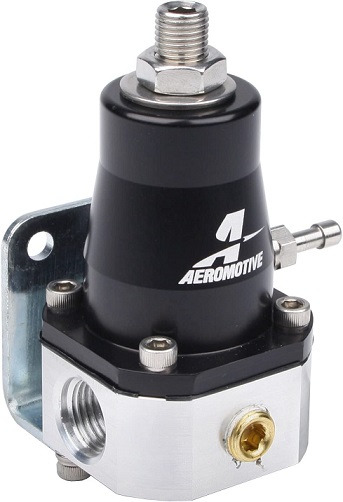
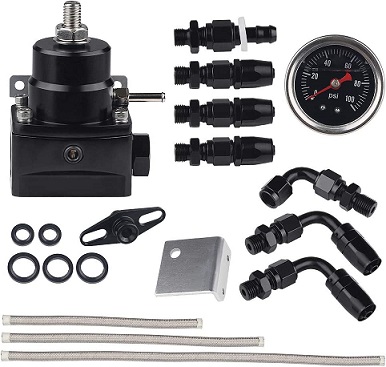
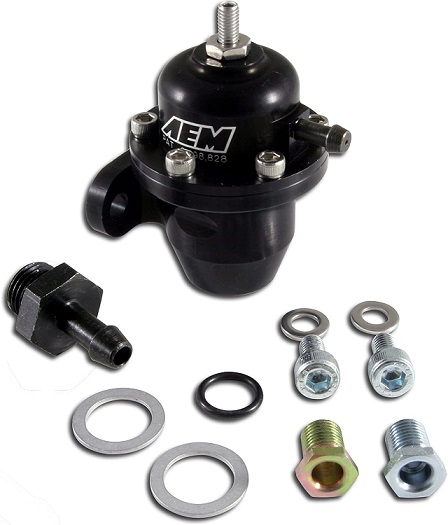
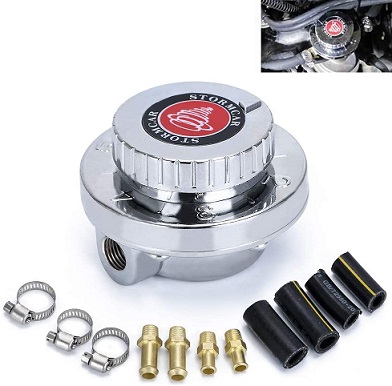
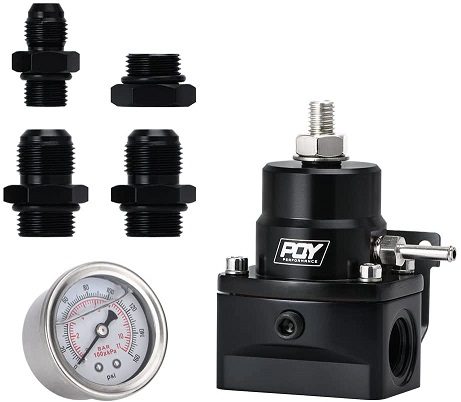
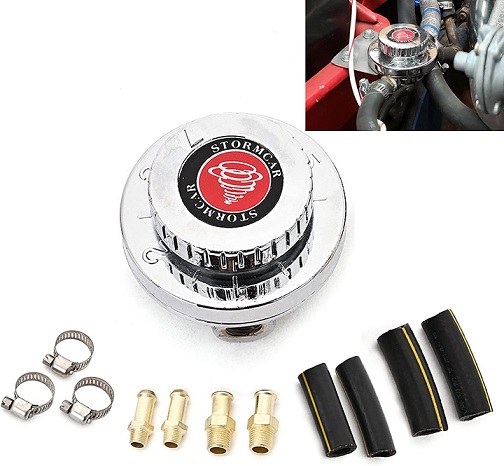
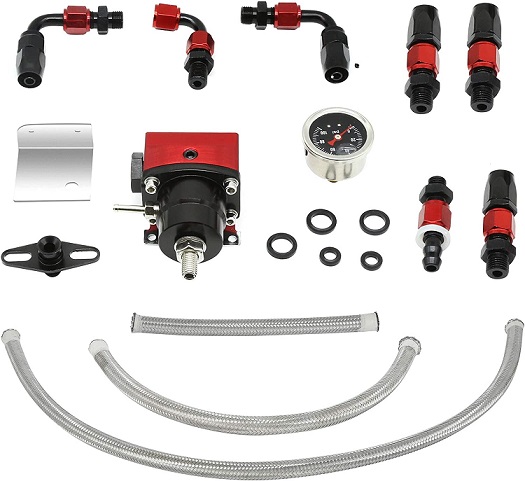
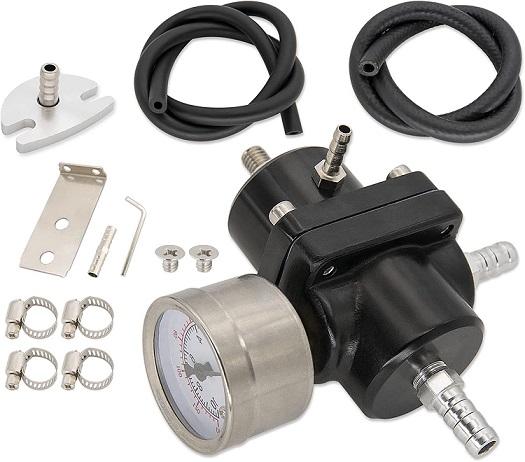


![]()